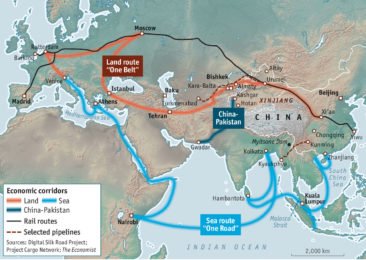China’s Belt and Road Initiative
Why in New?
- The meeting for China’s Belt and Road Initiative took place in Beijing on October 17; for the third time, India has decided not to attend the Belt and Road Initiative summit in China due to worries over sovereignty and the feasibility of Beijing’s initiatives. India did not bother to join the summits in 2017 and 2019.
- The two-day meeting is taking place amid criticism that financing for unsustainable projects has put smaller nations in financial traps. For the summits in 2017 and 2019, India stayed home.
- India remains unwavering in its criticism of the BRI, its centrepiece, the USD 60 billion China-Pakistan Economic Corridor (CPEC), which supersedes New Delhi’s concerns about sovereignty and is being built via Pakistan-occupied Kashmir (PoK).
What is the Road and Belt Initiative?
- BRI was launched by China President Xi Jinping in 2013 during an official visit to Kazakhstan and Indonesia countries.
- Road and Belt Initiative is also known as the BRI (Belt and Road Initiative) or New Silk Road of the 21st century. It was known as the One Belt, One Road Initiative earlier, and then the Belt Road Initiative was finalised.
- BRI programs were to build a physical infrastructure connecting East Asia and Europe. Since then, the initiative has been expanded to include Latin America, Oceania, and Africa. It includes more than 2900 projects that are under construction or ready.
- China has spent more than a million trillion on the 10-year-old BRI and as per a recent meeting, more than 100 countries have given verbal & and written consent.
- The Silk Road Economic Belt and the 21st Century Maritime Silk Road are two components of China’s Belt and Road Initiative. The land-based component, namely the Silk Road Economic Belt, focuses on developing infrastructure, such as railways, highways, pipelines, and other transportation links, to connect China with Europe via Central Asia and the Middle East. Meanwhile, the sea-based component, the 21st Century Maritime Silk Road, aims to enhance maritime routes between China, Southeast Asia, South Asia, Africa, and Europe and involves the development of ports and maritime infrastructure.
- China is being blamed for using debt-trap diplomacy for low-small countries.
Debt Trap countries: – Pakistan, Maldives, Mongolia, Kyrgyzstan, Djibouti, Laos & Sri Lanka and many more.
BRI Purpose:
- The purpose of BRI is to build a massive infrastructure using Roads, Railway, Ports, Oil and gas Industries and energy projects.
- To promote economic prosperity and regional economic cooperation within BRI route countries.
- To improve Finance, Trade and people-to-people connectivity globally.
- The original goal of the
Indian Government Response
- India has made an effort to persuade nations that the BRI is part of a plot to rule Asia, warning against what some experts have dubbed a “String of Pearls” geoeconomic strategy in which China loads its neighbours in the Indian Ocean with unmanageable debt to gain control of key choke points in the region.
- India has also been outspoken in its opposition to the BRI projects, arguing that they should be based on generally accepted international standards, good governance, and the rule of law, and adhere to openness, transparency, and financial sustainability principles.
“String of Pearls“: – The “String of Pearls” is a term used to describe China’s strategic infrastructure and naval buildup in the Indian Ocean region. It refers to a network of ports and other facilities built or controlled by China along the maritime routes that connect the country to the Middle East and Africa via the Indian Ocean. These ports and infrastructures are considered a chain of strategic assets in the shape of pearls along the marine trade routes. Countries such as Pakistan, Sri Lanka, Myanmar, Bangladesh, and others may have ports and facilities included in the “String of Pearls.”
Impact: – Any development comes with benefits and drawbacks. The BRI could be a Trojan horse for Chinese-led regional development and military enlargement, according to some observers and the United States shares concerns in Asia about this possibility. To make BRI work China must answer other countries’ questions with dignity.
Conclusion: – The Belt & Road Initiative seems to be useful to the world if its only purpose is to connect the world peacefully; however, it failed to convince many countries.
Best Online Coaching for Civil Service_IAS_ UPSC_IFS_IPS
Free Study Material ENSEMBLE IAS ACADEMY | Call +91 98115 06926 |
Visit us: – https://ensembleias.com/ | Online Store: https://online.ensemble.net.in/
#BRI #international_relations #India #Beltandroadinitiative #trendsingeography #explorepage #chinaIndiarelation # #Upsc_current_affairs #Indiangovt #GSPaper #UPSC #ias #upsc_exam #civilservices #civil_services_study #ensemble_ias_academy #geography_optional #ias #upsc_exam #civilservices #upsc_motivation #upsc_aspirants #trendsingeography






